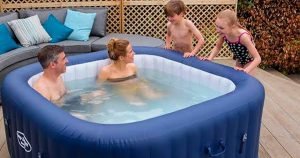Wiring a spa-style hot tub is a big deal, especially since it involves water and live electricity.
If you don’t have a lot of confidence or experience, it’s better to hire a licensed electrician.
Yeh guide aapko sabse naye zaroorat aur surakshit kadam ke saath le jaayega.

1. Local Code, Permits, and Planning
- First, check with your local government or building inspector to see if you need a permit to install your spa.
- Check the electrical specification manual of the spa before you buy it.
Modern spas use 240-volt wiring or a circuit with a lot of amperage. - Choose a place: inside or outside? Outdoor, but the wiring must go through a trench or conduit.
2. Compatibility and Electrical Needs
- Bahut se modern spas ko 240-volt / 50-amp (ya 50-60 amp) circuit ki zarurat hoti hai.
- Smaller plug-and-play spas can run on a 120 V outlet, but the heating and jet power will be limited.
- Check the main service panel in your house to see if there are any available breaker slots and if it can handle the service load.
- The manufacturer’s manual tells you the size of the wires, the type of conductor, and the number of wires.
For example, a 4-wire system (2 hot wires, 1 neutral, and 1 ground) is common.
3. Running the Path for the Conduit and Wiring
- If the agar spa is outside, you may have to dig a trench.
The minimum depth is usually 18 inches or whatever your local code says. - PVC conduit (or approved conduit) use karein wires ko protect karne ke liye.
- Wires will go from the spa control pack to the GFCI panel and then to the main service panel.
- Conduit and proper fixing are also important for installation above ground or inside.
4. Putting in the GFCI Disconnect and Connecting It
- A separate GFCI (Ground Fault Circuit Interrupter) breaker/disconnect panel is required for the spa.
- There should be clear markings on the “LINE” (incoming power) and “LOAD” (to spa) sides of the GFCI panel and spa.
- When you connect wires to the spa’s control box:
- Green = Ground
- White = Neutral (only if there are four wires)
- Red and Black (or two hots) are the power legs in a 240 V system.
- Carefully connect the wires in the main breaker panel:
hot wires to the double-pole breaker, neutral wires to the neutral bus bar, and ground wires to the grounding bar.
5. Final Approval, Testing, and Inspection
- After the wiring is done, double-check that all the connections are tight, the wiring gauge is right, and the conduit is installed correctly.
- Get a final inspection from a licensed building inspector or electrician.
This lowers the risk of the warranty being voided and makes sure safety. - Test the spa after restoring power:
make sure the breaker doesn’t trip and the jets and heater work properly.
6. Mistakes That People Often Make and How to Avoid Them
- Wire gauge chota lena — result: overheat, fire hazard.
- If you don’t ground it right or mix up the neutral and ground, the breaker bar will trip.
- Don’t use conduit or protection, or make the underground wiring less deep.
- Ignoring the local electrical code is not a good idea because it could void your warranty and put your safety at risk.
7. Last Thoughts
It’s not as easy as just plugging in a spa.
This is a high-voltage, high-current system where even a small mistake can be very expensive or dangerous.
If you don’t think this job will go perfectly, hire your own electrician.
Use this guide as a summary.
Always check the manufacturer’s manual and local codes for the most up-to-date information.
Cheers to a safe and relaxing time in your spa!





